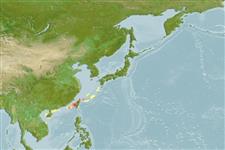Common names from other countries
Teleostei (teleosts) >
Anguilliformes (Eels and morays) >
Muraenidae (Moray eels) > Muraeninae
Etymology: Gymnothorax: Greek, gymnos = naked + Greek, thorax, -akos = breast (Ref. 45335); taiwanensis: Named for its type locality, Taiwan..
Environment: milieu / climate zone / depth range / distribution range
Ecology
Marine; reef-associated; depth range 3 - 30 m (Ref. 79874). Subtropical
Northwest Pacific: Taiwan.
Size / Weight / Age
Maturity: Lm ? range ? - ? cm
Max length : 53.1 cm TL male/unsexed; (Ref. 121652); 53.9 cm TL (female); max. published weight: 262.00 g (Ref. 121652)
Short description
Morphology | Morphometrics
Vertebrae: 117 - 121. This moderately sized moray is distinguished by having the anus behind the mid-body; short jaws; stout teeth, with vomerine teeth biserial; body color brownish with pale thin reticular pattern; when fresh with yellowish mucus on skin surface; darkish tips or rims on nostrils; orange irises; mean vertebral formula 5-55-119 (Ref. 79874).
Occurs in shallow reef and rocky shorelines, benthic. Feeds mainly on crustaceans and small fishes. All female specimens were found with ripe ovaries with ova measuring about 0.8-1.0 mm in diameter. Spawning apparently occurs near or from July- August (Ref. 79874).
Life cycle and mating behavior
Maturity | Reproduction | Spawning | Eggs | Fecundity | Larvae
Chen, H-M., K-H. Loh and K-T. Shao, 2008. A new species of moray eel, Gymnothorax taiwanensis, (Anguilliformes: Muraenidae) from Eastern Taiwan. The Raffles Bull. Zool. 19:131-134. (Ref. 79874)
IUCN Red List Status (Ref. 130435)
CITES (Ref. 128078)
Not Evaluated
Threat to humans
Harmless
Human uses
More information
Common namesSynonymsMetabolismPredatorsEcotoxicologyReproductionMaturitySpawningFecundityEggsEgg development
Age/SizeGrowthLength-weightLength-lengthLength-frequenciesMorphometricsMorphologyLarvaeLarval dynamicsRecruitmentAbundance
ReferencesAquacultureAquaculture profileStrainsGeneticsElectrophoresesHeritabilityDiseasesProcessingMass conversion
Tools
Special reports
Download XML
Internet sources
Estimates based on models
Preferred temperature (Ref.
115969): 24.5 - 27.5, mean 25.9 (based on 144 cells).
Phylogenetic diversity index (Ref.
82804): PD
50 = 0.5000 [Uniqueness, from 0.5 = low to 2.0 = high].
Bayesian length-weight: a=0.00052 (0.00035 - 0.00079), b=3.28 (3.16 - 3.40), in cm Total Length, based on LWR estimates for this species & Genus-body shape (Ref.
93245).
Trophic level (Ref.
69278): 3.9 ±0.6 se; based on size and trophs of closest relatives
Resilience (Ref.
120179): Medium, minimum population doubling time 1.4 - 4.4 years (Preliminary K or Fecundity.).
Fishing Vulnerability (Ref.
59153): Moderate vulnerability (42 of 100).
